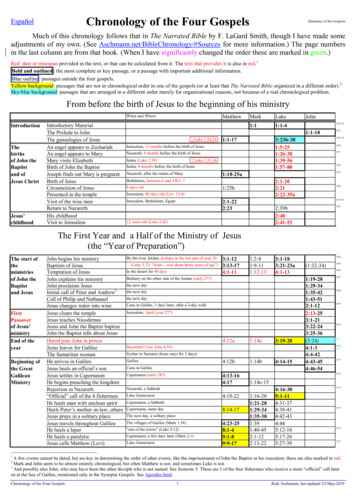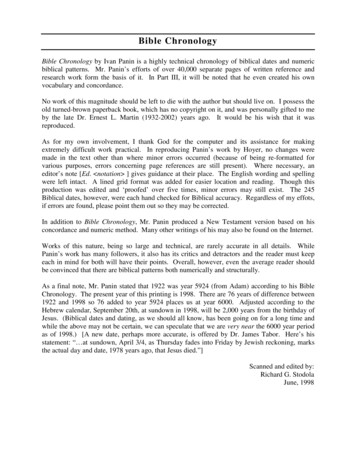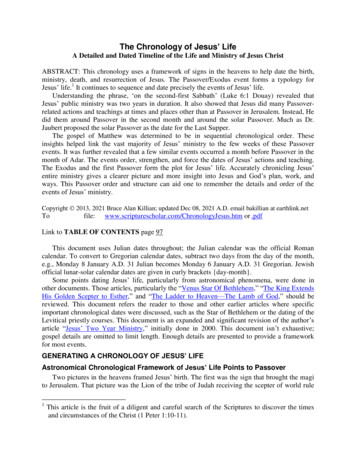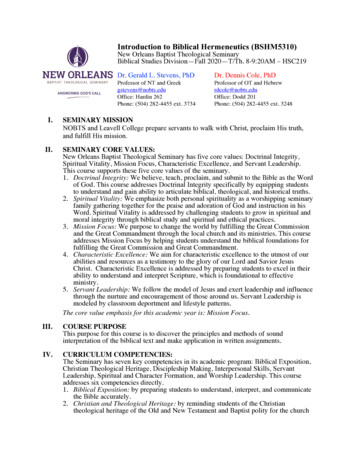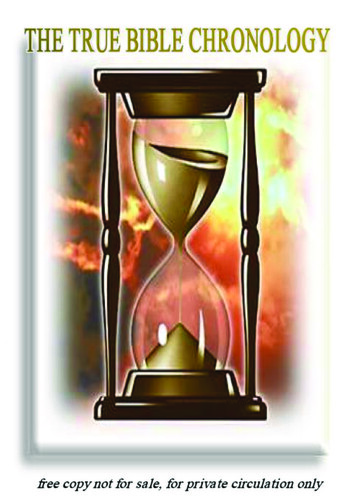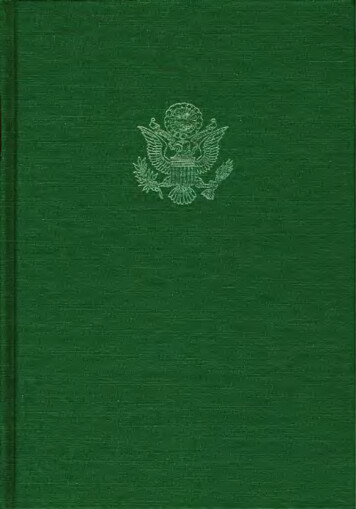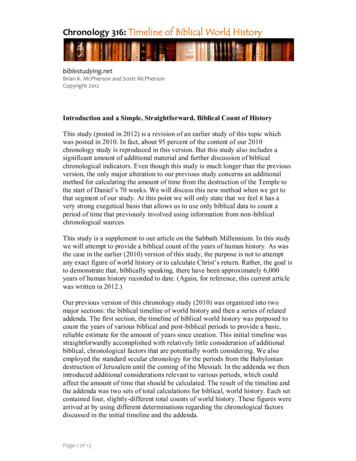
Transcription
Chronology 316: Timeline of Biblical World Historybiblestudying.netBrian K. McPherson and Scott McPhersonCopyright 2012Introduction and a Simple, Straightforward, Biblical Count of HistoryThis study (posted in 2012) is a revision of an earlier study of this topic whichwas posted in 2010. In fact, about 95 percent of the content of our 2010chronology study is reproduced in this version. But this study also includes asignificant amount of additional material and further discussion of biblicalchronological indicators. Even though this study is much longer than the previousversion, the only major alteration to our previous study concerns an additionalmethod for calculating the amount of time from the destruction of the Temple tothe start of Daniel’s 70 weeks. We will discuss this new method when we get tothat segment of our study. At this point we will only state that we feel it has avery strong exegetical basis that allows us to use only biblical data to count aperiod of time that previously involved using information from non-biblicalchronological sources.This study is a supplement to our article on the Sabbath Millennium. In this studywe will attempt to provide a biblical count of the years of human history. As wasthe case in the earlier (2010) version of this study, the purpose is not to attemptany exact figure of world history or to calculate Christ’s return. Rather, the goal isto demonstrate that, biblically speaking, there have been approximately 6,000years of human history recorded to date. (Again, for reference, this current articlewas written in 2012.)Our previous version of this chronology study (2010) was organized into twomajor sections: the biblical timeline of world history and then a series of relatedaddenda. The first section, the timeline of biblical world history was purposed tocount the years of various biblical and post-biblical periods to provide a basic,reliable estimate for the amount of years since creation. This initial timeline wasstraightforwardly accomplished with relatively little consideration of additionalbiblical, chronological factors that are potentially worth considering. We alsoemployed the standard secular chronology for the periods from the Babyloniandestruction of Jerusalem until the coming of the Messiah. In the addenda we thenintroduced additional considerations relevant to various periods, which couldaffect the amount of time that should be calculated. The result of the timeline andthe addenda was two sets of total calculations for biblical, world history. Each setcontained four, slightly-different total counts of world history. These figures werearrived at by using different determinations regarding the chronological factorsdiscussed in the initial timeline and the addenda.Page 1 of 13
Chronology 316: Timeline of Biblical World Historybiblestudying.netHowever, as we stated in that previous version of the study, these totals were notmeant to be taken as absolute, dogmatic figures. The purpose of that previousstudy as well as this current version is the same. We simple wish to provide thebiblical and historical data that is relevant to any biblical student who wishes toattempt to count the total years of world history since creation. The goal is toavoid making calculations based on an overly simplistic or under-informedunderstanding of the factors of biblical chronology. The reason for this revisedversion is to include some additional factors as well as further biblical insightsthat the biblical chronologist should be aware of as they study biblical, worldhistory.This version of our study (2012) will present the chronological material in aslightly different manner than the previous version (2010). As with the previousversion, we will divide our study into different sections covering specificsegments of biblical, world history. However, unlike our previous version, wewill not relegate additional, potentially significant biblical or chronologicalconsiderations to the addenda. Instead, as we cover each segment of world historywe will include all of the potentially relevant chronological factors for that period.At times, this will produce different possible amounts of time for particularperiods. The task of the student of biblical chronology will be to determine themost reasonable and consistent approach through an informed grasp of thepotential biblical and chronological factors.As with our previous version, various totals for the years of world history will beproduced based on any particular selection of factors for how each period shouldbe calculated. However, our purpose is not to argue that each of the possible totalsis equally sound. Nor is it our purpose to argue that a total count is impossible todeduce from the information available. Of the possibilities that we will produce,biblical data will show that some total counts will be stronger than others. Most ofus will find one of the calculations to be more compelling than the otherpossibilities. The reason we include the various possible, influential factors andthe resulting variety of totals they produce is so that the reader can be informed asthey make their selections as to the most biblically-responsible total. Our desire isto avoid adopting a particular chronological conclusion in the interest ofsupporting a particular view and without an awareness of other potentially criticalissues.Before we proceed to examining the chronological material and time periodsrecorded in the bible, we should consider the issue of sufficiency. Chronologies ofworld history are constructed using various means including the chronicleswritten by ancient historians, archeological data such as inscriptions, and evenradio-metric dating. Although at times we will mention the dates provided bysecular historians alongside the biblical material for comparison, this study willinstead rely on biblical data to construct a timeline of world history. Since ourpurpose is to derive a total history of the world using biblical data, we mustaddress the sufficiency and adequacy of the bible and the chronological data itcontains.Page 2 of 13
Chronology 316: Timeline of Biblical World Historybiblestudying.netThis study will operate on the conclusion that the bible is the inerrant,authoritative, and wholly reliable source of truth. Implicit in this commonChristian view of the scriptures is the notion of the adequacy of the bible. Theseissues have particular importance regarding attempts to create a biblically-basedchronology of world history. The derivation of a history of the world that relies onbiblical data (rather than non-biblical sources) operates on several fundamentaland essential premises.Constructing a chronology of world history using biblical data involves the notionthat the biblical authors intended to preserve chronological data in their texts forthe purpose of being used to understand the amount of years that elapsed duringthe particular periods of history that they discuss. If the biblical authors did notintend to record chronological data for the purposes of allowing for a timeline ofthe historical periods they discuss, then we are perhaps misguided in undertakingand hoping to succeed at a task they never intended using material they neverintended to be used for that purpose.If, on the other hand, we hold that the biblical authors preserved chronologicaldata in their texts with the intention of allowing us to understand the timeline andthe duration of the period of history they discuss, then we correspondingly alsohold that the data they provided is sufficient for that purpose. If they intended toprovide a timeline of historical periods, but the data they provided for thatpurpose was insufficient or inadequate for accomplishing that goal, then thebiblical authors were incompetent.If we do not hold the biblical authors to be incompetent then the only way we cansuggest that their data is insufficient would be to suggest that the insufficiency isdue to a lack of intention on their part to facilitate an accurate calculation of thehistory of the period they are describing. If such a calculation was not intendedand the data is insufficient for doing so, then we cannot be confident that anymechanism we devise for correcting or accounting for unaccounted for time willbe able to adequately overcome the insufficiency of the biblical material itselfwith regard to this particular task. Moreover, attempts to fill in the gaps notprovided by biblical authors must be immediately acknowledged as departuresfrom a strictly biblical chronology, which by definition, must rely on dataprovided in the bible, not adjustment techniques devised by uninspired men livingcenturies later. It would be even more doubtful to suggest that we would be ableto come up with a method for calculating missing data with certainty, therebysurpassing even the chronological sufficiency of the texts themselves. Again, itwould seem contradictory to suggest that we are able to accomplish somethingthat the biblical authors did not do themselves, did not intend for us to do, and didnot supply us with sufficient data to accomplish.If then, we hold that the biblical authors preserved chronological data with theintention that such data would provide a timeline of the historical period theydescribe, then we must take that data to be sufficient and adequate for deriving anaccurate history of the world. To suggest that the chronological material preservedPage 3 of 13
Chronology 316: Timeline of Biblical World Historybiblestudying.netin the bible by its inspired authors is in need of supplementation by non-biblicalsources or through the efforts of non-biblical chronologists forfeits the premisethat is essential to the endeavor of creating a chronology of world history usingthe bible alone. (It must be noted that our intention here is not to take a stance onthe potential validity or usefulness of timelines produced using both biblical andextra-biblical source material. Rather, our point is simply that when the expressedintent is to develop a chronology using the bible alone, only the data found in thebible can be included.)In an article discussing Daniel 9’s prophecy of the seventy weeks, author andpastor Tim Warner articulates these considerations aptly as he addresses otherscholarly work in this area and the question of whether the bible fails to accountfor the time between the Babylonian destruction of the Temple and the start ofDaniel’s 70 weeks prophecy.The Bible gives us intricate chronological data for all the periods of timefrom creation until the crucifixion of Christ. But, if we link the start of the 70weeks to any command except the first one given by Cyrus, we have a huge holein the data. Even chronologists who claim to base their work on Biblical dataalone fill in the supposed missing Biblical data using secular data. For example,Dr. Floyd Nolan Jones’ recent work, ‘The Chronology of the Old Testament,’claims to be in what he calls the “Biblicist” school, which he described asfollows: “The goal of the members of this school is to construct a standardchronology of the Bible from the chronological data embedded within theHebrew Masoretic Text of the Old Testament, independent of any outsidesources. In the past, James Ussher has been its leading proponent.” Both Ussherand Jones have failed to achieve this stated goal. Both of them used Biblicaldata alone to date from Creation to the Babylonian captivity. And they usedbiblical data (the 69 “weeks” of Daniel 9) to calculate from Artaxerxes’decree to Nehemiah until Christ’s crucifixion. However, both Ussher andJones used secular data to fill in the gap between the end of the Babyloniancaptivity and the 20th year of Artaxerxes, the year they assume Daniel’s 69weeks began, based on Nehemiah 2. The Bible simply does not give us thechronological data from Cyrus’ decree ending the Babylonian captivity untilArtaxerxes. So, these chronologists rely on secular dates for the succession andreigns of the Persian kings. Yet, the reliability of the secular data, particularly thedates and list of Persian kings in Ptolemy’s Canon, (the primary source for thePersian period), are highly suspect. I am convinced that since God took thetrouble to record and preserve in His Word complete chronologies fromcreation until the end of the Babylonian captivity, and He provided a preciseprophetic chronology of “weeks” of years (for the intertestamental period)until the cutting off of the Messiah, He did not fail to provide absolutelyeverything we need for a complete biblical chronology, without the need tosupplement the data with secular sources which are unreliable. – Tim Warner,Daniel’s 70 Weeks, On Second Thought, www.answersinrevelation.orgIn the quote above, Warner makes two important observations. First, he states thatthe goal of deriving a count of world history using the bible itself involves thePage 4 of 13
Chronology 316: Timeline of Biblical World Historybiblestudying.netpremise that, the “Bible gives us intricate chronological data for all the periods oftime from creation until the crucifixion of Christ.” Second, he states that we canconstruct a chronology independent of outside sources because God “did not failto provide absolutely everything we need for a complete biblical chronology,without the need to supplement the data with secular sources which areunreliable.” Therefore, once we commit to the idea that non-biblical sources arenot needed to supplement the bible because the bible contains intricatechronological data sufficient for deriving a total chronology of world history(prior to the crucifixion of Christ), then we are precluded from fine-tuning,modifying, or correcting our calculation of the biblical data on the basis ofadjustment methods and amounts of time that are not provided in the bible itself.Though Warner is here articulating these principles in regard to a specific periodof historical inquiry, it is our understanding that he intends these principles to beapplied universally in chronological studies of this kind. And for the purposes ofdeveloping a chronology strictly from biblical information, we wish to state ouragreement with the general application of these principles to all periods of biblicalhistory.These considerations and implications may seem self-evident. We discuss themhere because they are relevant to choices that will arise regarding thechronological data that we examine in the bible regarding various historicalperiods. These issues will emerge during the course of our study. For now, it isimportant to stipulate a foundational and critical premise of this study. Thatessential concept is that attempts to derive a chronology of world history from thebible must inherently operate on the principle that the scriptural data is bothintended for and sufficient for producing that result. When we encounterchronological data in a biblical text, it will be entirely appropriate to understandhow the author intended that material to be understood. But, we will have to bekeenly aware of when interpretations and approaches to calculation involvesuggesting an inadequacy in the data itself with regard to informing us of thedurations of time contained in the periods of biblical world history.Throughout our study, we will at times provide the amount of years of biblicalhistory since creation. This total will be identified with the letters AM, anabbreviation for the Latin term Anno Mundi, meaning “year of the world.” ThisLatin term is commonly used for the purpose of calculating the number of yearsof biblical history.Anno Mundi – Anno Mundi (Latin: "in the year of the world") abbreviated asAM or A.M., refers to a Calendar era counting from the Biblical creation ofthe world. – wikipedia.orgFor reference, the Hebrew calendar also counts the number of years from thecreation of the world. The calendar year beginning September 19, 2009 throughSeptember 8, 2010 was equivalent to the year 5770 by this Hebrew reckoning. Asof September 9, 2010 the Hebrew calendar began the year 5771 AM, AnnoMundi.Page 5 of 13
Chronology 316: Timeline of Biblical World Historybiblestudying.netHebrew Year – The present counting method for years use the Anno Mundiepoch (Latin for "in the year of the world", abbreviated AM or A.M. and alsoreferred to as the Hebrew era. Hebrew year 5770 began on 19 September 2009and ended on 8 September 2010. Hebrew year 5771 (a leap year) began on 9September 2010 and ends on 28 September 2011. – wikipedia.comHere is a brief look ahead at the sections we will cover as we proceed through thisstudy.1. Period One: From Creation to the Birth of Isaac2. Period Two: From the Birth of Isaac to the Exodus3. Period Three: From the Exodus to the Beginning of Solomon’s Reign4. Period Four: From the Beginning of Solomon’s Reign to the Destruction of theTemple5. Period Five: From the Destruction of the Temple to the Decree of Daniel 96. Period Six: The Decree of Daniel 9 to the Messiah7. Period Seven: The Messiah to the Present8. Period Eight: At Least 7 Years Before Christ’s ReturnEach of these sections will contain an in-depth look at calculations andchronological data regarding these periods of history. Several of the sections willbe subdivided into multiple parts. Before we proceed to what, at times, will be ainvolved discussion, we would first like to present a basic, simple, straightforwardchronology of world history from biblical data.The first period of biblical history spans the beginning of creation to the Flood.Biblical data for this period is contained in the genealogical accounts of Genesis 5and 7. Below is a list of the relevant amounts of time along with the relevantscripture passages where that information is provided. Using just this biblical datawould allow us to conclude that the Flood began at 1656 years from creation, inthe year 1656 AM (Anno Mundi).Adam was created on the sixth day of creation (Genesis 1:23-31) and he was 130years old when Seth was born (Genesis 5:3).Seth was 105 years old when Enos was born (Genesis 5:6).Enos was 90 years old when Cainan was born (Genesis 5:9).Cainan was 70 years old when Mahalaleel was born (Genesis 5:12).Mahalaleel was 65 years old when Jared was born (Genesis 5:15).Jared was 162 years old when Enoch was born (Genesis 5:18).Enoch was 65 years old when Methusaleh was born (Genesis 5:21).Methusaleh was 187 years old when Lamech was born (Genesis 5:25).Lamech was 182 years old when Noah was born (Genesis 5:28-29).According to Genesis 7:11, Noah was 600 years old when the Flood occurred.The next segment of biblical history proceeds from the Flood in 1656 AM to thebirth of Abraham. As with the previous period this section of biblical history isprovided through genealogical data. This data is derived chiefly from Genesis 11.Page 6 of 13
Chronology 316: Timeline of Biblical World Historybiblestudying.netBut in order to calculate the amount of time to Abraham’s birth we will need to doa little bit of cross referencing with other verses.Genesis 11:26 states that Terah (Abraham’s father) was 70 years old and that hebegat three sons: Abraham (Abram,) Nahor, and Haran.Genesis 11:26 And Terah lived seventy years, and begat Abram, Nahor, andHaran.As we can see, this verse does not tell us how old Terah was at the birth of each ofhis sons (or more specifically at the birth of Abraham.) We can determine Terah’sage at Abraham’s birth by looking at a few other nearby verses.Genesis 11:32 explains that Terah died in Haran at 205 years of age.Genesis 11:32 And the days of Terah were two hundred and five years: andTerah died in Haran.Just after this, Genesis 12:4 tells us that Abraham left Haran at 75 years of age.Genesis 12:4 So Abram departed, as the LORD had spoken unto him; and Lotwent with him: and Abram was seventy and five years old when he departedout of Haran.By putting the information contained in these passages together we can see thatAbraham was 75 years old when his father Terah died at age 205. So, if Abrahamwas 75 when Terah died at 205, then Terah must have been 130 when Abrahamwas born (205 – 75 130.)Now that we know how old Terah was when Abraham was born we can get a totalnumber of years for the period from the Flood until Abraham’s birth and we canadd it to our running total of biblical history. Below is the biblical count of yearsfrom the Flood until the birth of Abraham. A simple count of these amountswould allow us to conclude that there were 352 years between the Flood andAbraham’s birth.Noah's son Shem had a son named Arphaxad, 2 years after the Flood (Genesis11:10).Arphaxad was 35 years old when he had a son named Salah (Genesis 11:12).Salah was 30 years old when he had a son named Eber (Genesis 11:14).Eber was 34 years old when he had a son named Peleg (Genesis 11:16).Peleg was 30 years old when he had a son named Reu (Genesis 11:18).Reu was 32 years old when he had a son named Serug (Genesis 11:20).Serug was 30 years old when he had a son named Nahor (Genesis 11:22).Nahor was 29 years old when he had a son named Terah (Genesis 11:24).Terah was 130 years old when he had a son named Abram (Genesis 11:26,32,12:4, Acts 7:4).Page 7 of 13
Chronology 316: Timeline of Biblical World Historybiblestudying.netLikewise, according to Genesis 21:5, Abraham was 100 years old when his sonIsaac was born.Genesis 21:5 And Abraham was an hundred years old, when his son Isaacwas born unto him.In this next section of biblical world history we will need to do some crossreferencing and comparison of scriptural texts. We will start with Genesis 15:1316.In Genesis 15:13-16, God tells Abraham that his descendents will be servants in aland that is not their own (Egypt) for 400 years and that they will come out in thefourth generation.Genesis 15:13 And he said unto Abram, Know of a surety that thy seed shall bea stranger in a land that is not theirs, and shall serve them; and they shallafflict them four hundred years; 14 And also that nation, whom they shallserve, will I judge: and afterward shall they come out with great substance. 15And thou shalt go to thy fathers in peace; thou shalt be buried in a good oldage. 16 But in the fourth generation they shall come hither again: for theiniquity of the Amorites is not yet full.From this passage we learn several things. In verse 13, God refers to Abraham’sseed and then describes a period of 400 years. From this we may conclude that the400 years mentioned here would begin with the first generation of Abraham’sdescendants (or seed.) Therefore, Genesis 15 seems to use the birth of Isaac tomark the beginning of the 400 years.We should take into account that Exodus 12:40-41 states that the children ofIsrael (Abraham’s descendants) sojourned for 430 years.Exodus 12:40 Now the sojourning of the children of Israel, who dwelt inEgypt, was four hundred and thirty years. 41 And it came to pass at the end ofthe four hundred and thirty years, even the selfsame day it came to pass, thatall the hosts of the LORD went out from the land of Egypt.There are several reasons why this may seem to contradict what we just read inGenesis 15. First, Genesis 15 mentions a period of 400 years that concludes withAbraham’s descendants leaving Egypt. Exodus 12 refers to a period of 430 yearsending at the same event. And, according to Acts 7:6 and Genesis 15:13-16, bothperiods deal with the time of Israel’s sojourning. These amounts (400 and 430)are obviously not equivalent to one another.Second, Genesis 15:13-16 (and Acts 7:6) seems to indicate that the entire periodfrom the birth of Isaac to the Exodus would only be 400 years. Additionally,Genesis 46 (verses 5-28, 31) and Genesis 47 (verses 1, 5, 27-29) indicate that thedescendants of Israel didn’t go to Egypt until the time of Jacob, Abraham’sgrandson. If the 430 years starts at the time of Jacob’s entrance into Egypt thenPage 8 of 13
Chronology 316: Timeline of Biblical World Historybiblestudying.netthese passages seem to conflict with one another. For, 430 years starting whenJacob was 130 years old is much longer than 400 years starting with Isaac’s birth190 years earlier. (Isaac was 60 when Jacob was born – Genesis 25:26. Jacob was130 when he and his family went to Egypt – Genesis 47:8-9. Therefore, Isaac wasborn 190 years before Jacob and his family went to Egypt.) Since both amountsend at the same time, this seems like a potential discrepancy.This conflict is not really a difficult one and the resolution is, in fact, well known.In Galatians 3:16-17, Paul explains that the covenant that God gave to Abrahamcame 430 years before the Law that Moses gave during the Exodus.Galatians 3:16 Now to Abraham and his seed were the promises made. Hesaith not, And to seeds, as of many; but as of one, And to thy seed, which isChrist. 17 And this I say, that the covenant, that was confirmed before of Godin Christ, the law, which was four hundred and thirty years after, cannotdisannul, that it should make the promise of none effect.It is worth noting that Paul uses the same amount of time as Exodus 12 (430years.) However, the important thing is that Paul indicates that the 430 yearsspans from the time Abraham received the promise until the Exodus when Mosesgave the Law to Israel. Therefore, according to Paul, there were 430 yearsbetween the time Abraham received the promise and the Exodus.Genesis 12:1-4 provides an indication of when Abraham first received thepromise to inherit Canaan Land.Genesis 11:32 And the days of Terah were two hundred and five years: and Terahdied in Haran. 12:1 Now the LORD had said unto Abram, Get thee out of thycountry, and from thy kindred, and from thy father’s house, unto a land that Iwill shew thee: 2 And I will make of thee a great nation, and I will bless thee,and make thy name great; and thou shalt be a blessing: 3 And I will blessthem that bless thee, and curse him that curseth thee: and in thee shall allfamilies of the earth be blessed. 4 So Abram departed, as the LORD had spokenunto him; and Lot went with him: and Abram was seventy and five years oldwhen he departed out of Haran.As we can see from the context of this passage, Abraham had already receivedthis promise prior to the death of his father Terah. After Terah’s death (in chapter11:32,) chapter 12:1 immediately informs us that God had already given Abrahamthis promise. Now we know that Abraham was 75 years old when Terah died(verse 4.) So, we may presume that he was at least a few years younger when hefirst received this promise from God.If we pull the information in these passages together (Genesis 11, Genesis 15,Exodus 12, and Galatians 3) we can see that all of these texts are easilyreconciled. Abraham received the promise (to inherit Canaan Land) at the age of70 years old (five years before Terah’s death.) Thirty years later Isaac was bornwhen Abraham was 100 years old. Isaac’s birth marks the first generation ofPage 9 of 13
Chronology 316: Timeline of Biblical World Historybiblestudying.netAbraham’s descendants. According to Genesis 15:13-16, there would be 400years from the birth of Isaac to the Exodus in the fourth generation. Because ofthis Paul can say that the Law (given during the Exodus) came 430 years afterAbraham received the promise from God (at age 70.)Using these biblical texts we can deduce the amount of time from the birth ofIsaac to the Exodus as 400 years. This seems to fit with information providedelsewhere in the Old Testament.1 Kings 6:1 provides a simple and straightforward count of the amount of yearsfrom the Exodus to the time when Solomon began to build the Temple. Accordingto 1 Kings 6:1, Solomon began to build the Temple in the fourth year of his reign.This was during the 480th year after the Exodus.1 Kings 6:1 And it came to pass in the four hundred and eightieth year afterthe children of Israel were come out of the land of Egypt, in the fourth yearof Solomon’s reign over Israel, in the month Zif, which is the second month,that he began to build the house of the LORD.For the purposes of later calculations, it is easier to use the beginning ofSolomon’s reign as the marker for this period rather than the building of theTemple. With this in mind, we note that this was the 4th year of Solomon’s reignand the 480th year after the Exodus. It is most likely that this means that Solomonhad completed 3 years of reign and was currently in his fourth year. By the samereasoning, Israel would have completed 479 years since the Exodus and currentlybe in the 480th year. So, according to 1 Kings 6:1, there were 476 years betweenSolomon’s coronation as king and the Exodus from Egypt (479 – 3 476 or 480 –4 476.)The next period of biblical world history begins with the onset of King Solomon’sreign and ends with the desolation of Jerusalem and the Temple by theBabylonians under King Nebuchadnezzar. The amount of years contained in thisperiod can be determined by adding the total number of years of the kings ofJudah beginning with Solomon and ending with Zedekiah (the final king ofJudah). Below is a list of these kings, their years of rule, and the biblical passagesthat provide this data.David's son, Solomon reigned over Israel from Jerusalem for 40 years (1 Kings11:42-43).Solomon's son, Rehoboam reigned over Judah for 17 years (1 Kings 14:21).Rehoboam's son, Abijam reigned over Judah for 3 years (1 Kings 14:31, 1Kings 15:1-2).Abijam's son, Asa reigned over Judah for 41 years (1 Kings 15:8-10, 2Chronicles 16:13).Asa's son, Jehoshaphat reigned over Judah for 25 years (1 Kings 22:41-42).Jehoshaphat's son, Jehoram reigned over Judah for 8 years (1 Kings 22:50, 2Chronicles 21:1. 2 Chronicles 21:20).Jehoram's son, Ahaziah reigned over Judah for 1 year (2 Chronicles 22:2).Page 10 of 13
Chronology 316: Timeline of Biblical World Historybiblestudying.netAhaziah's mother, Athaliah reigned over Judah for 6 years (2 Chronicles 22:12).Ahaziah's son, Joash reigned over Judah for 40 years (2 Chronicles 23:1, 2Chronicles 24:1).Joash's
Chronology 316: Timeline of Biblical World History biblestudying.net Page 3 of 13 This study will operate on the conclusion that the bible is the inerrant, authoritative, and wholly reliable source of truth. Implicit in this c

